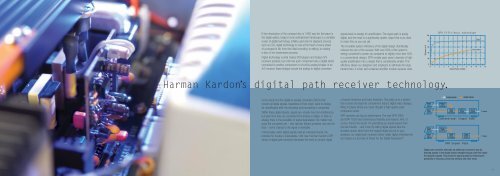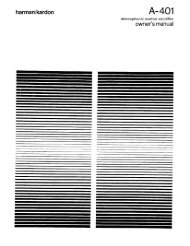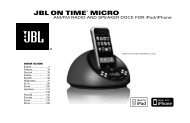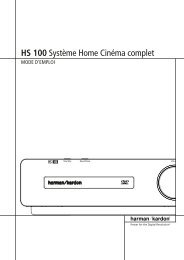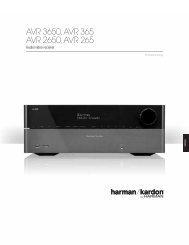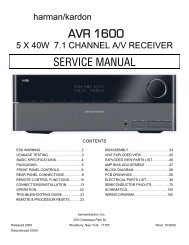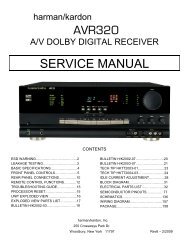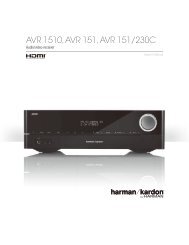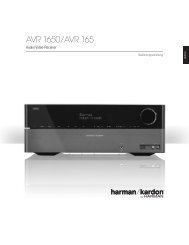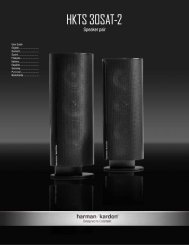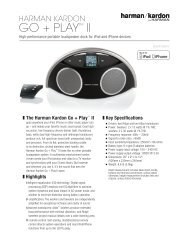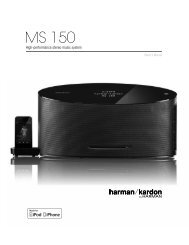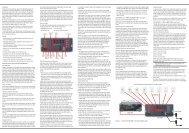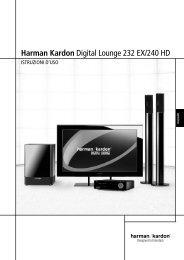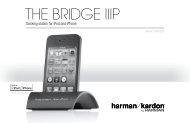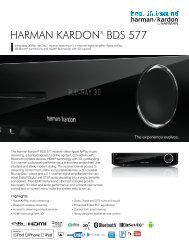You also want an ePaper? Increase the reach of your titles
YUMPU automatically turns print PDFs into web optimized ePapers that Google loves.
If the introduction of the compact disc in 1982 was the first wave in<br />
the digital waters, today’s home entertainment landscape is a veritable<br />
ocean of digital technology. Initially used only for playback sources<br />
such as CDs, digital technology is now at the heart of every phase<br />
of a program’s life, from the initial recording, to editing, to making<br />
a disc or the transmission process.<br />
Digital technology is what makes DVD players and today’s A/V<br />
receivers possible, but until now each component was a digital island<br />
connected to another component or circuit by analog bridges. In an<br />
A/V receiver, these bridges include the analog-to-digital converters<br />
signals back to analog for amplification. The signal path is purely<br />
digital, and the result is a significantly quieter output that is as close<br />
to noise-free as you can get.<br />
The incredible system efficiency of the digital design dramatically<br />
reduces the size of the receiver. With over 80% of the system’s<br />
energy converted to power (as compared to slightly more than 55%<br />
in a conventional design), DPR models pack seven channels of highquality<br />
amplification into a design that is considerably smaller. This<br />
efficiency allows our designers and engineers to eliminate the large<br />
transformers. A small, self-contained amplifier module replaces rows<br />
Efficiency in %<br />
Output Power in Watts<br />
DPR<br />
Conventional<br />
<strong>Harman</strong> <strong>Kardon</strong>’s digital path receiver technology.<br />
at the inputs and the digital-to-analog converters (DACs) that<br />
convert all digital signals, regardless of their origin, back to analog<br />
for amplification after the decoding and processing is completed.<br />
Within these digital islands, signals are virtually free from interference,<br />
but each time they are converted from analog to digital, or back to<br />
analog, there is the possibility of signal degradation. No matter how<br />
good the converters are – and <strong>Harman</strong> <strong>Kardon</strong> products use only the<br />
best – some change to the signal is inevitable.<br />
Unfortunately, when digital signals exist as individual blocks, the<br />
potential for trouble is inescapable. Until now. <strong>Harman</strong> <strong>Kardon</strong>’s DPR<br />
series of digital path receivers eliminates the need to convert digital<br />
of power transistors and bulky heatsinks. This adds up to a system<br />
that is sized and styled to complement today’s digital video displays,<br />
fitting in places where you never thought a high-quality audio<br />
component could.<br />
DPR receivers are big on performance. The new DPR 2005<br />
and DPR 1005 have tremendous flexibility and features. And, of<br />
course, there’s the sound. It’s everything you would expect from<br />
<strong>Harman</strong> <strong>Kardon</strong> – and more. By letting digital signals take the<br />
shortest course, direct from the original digital source to your<br />
speakers, our digital path receivers deliver totally digital entertainment<br />
and realize our promise of Power for the Digital Revolution. ® 11<br />
Digital path receivers eliminate an additional conversion step by<br />
keeping signals in the digital domain straight through until they reach<br />
the speaker outputs. This preserves signal quality by removing the<br />
possibility of inducing conversion artifacts and other noise.<br />
10


